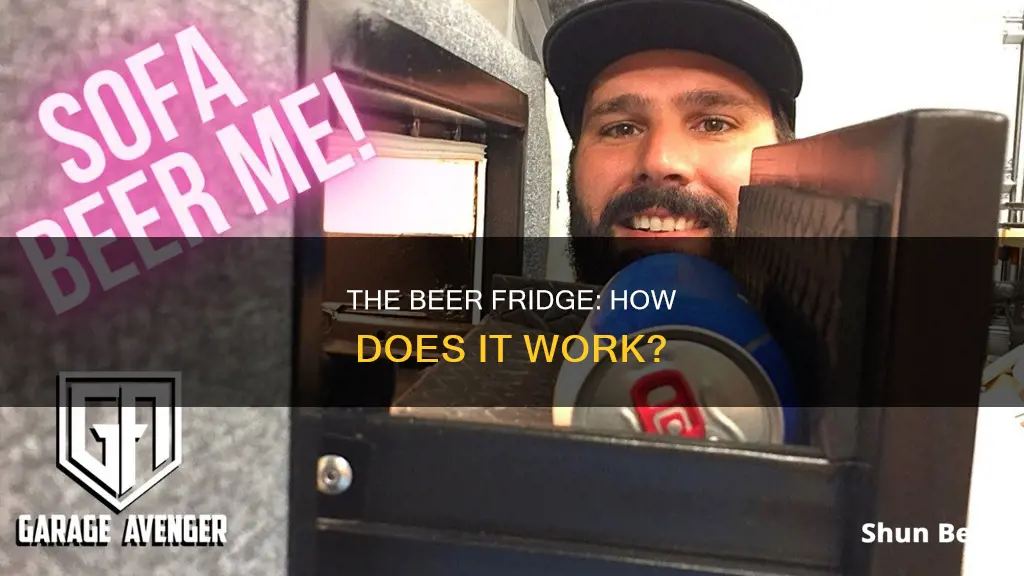
Beer is a delicate product, and its flavour can be affected by a number of factors. To ensure the best taste, it's important to understand how to store beer correctly. Beer is best stored in a cool, dark place, as light and heat can cause chemical reactions that alter its aroma and flavour. In addition, oxygen can age the beer, impacting both its colour and flavour. To avoid this, beer should be stored upright to minimise the surface area exposed to oxygen. For beer enthusiasts, investing in a dedicated beer fridge is a great option, as it allows for precise temperature control.
| Characteristics | Values |
|---|---|
| Fridge or freezer | Either a fridge or freezer will work, and they both have their own advantages and disadvantages. |
| Fridge size | Ensure your fermenter or fermenters will fit inside the fridge. |
| Thermostat | It doesn't matter if the thermostat doesn't function properly, as it can be bypassed. |
| Frost free | Look for a frost-free freezer if it's an upright model. |
| Temperature control | Add a temperature controller to keep the beer at the correct temperature. |
| Cleaning | Clean the fridge thoroughly, paying special attention to the rubber seal on the door and the area where the seal contacts the fridge. |
| Shelves | Remove any shelves that are not required to maximise space. |
| Lighting | Consider adding a light inside the fridge. |
| Hacks | There are various options to convert a fridge or freezer into a temperature-controlled fermentation chamber, from simple to advanced. |
What You'll Learn

Converting a fridge for fermenting beer
Home brewing is a fun and exciting way to make your own beer, but the fermentation process is very temperature-sensitive. Off flavours can easily develop if temperatures change by just a few degrees. A temperature-controlled fermentation chamber is a great way to ensure consistent, fine-tuned brews with extraordinary flavour profiles.
Choosing a Refrigerator
There are several common refrigerator designs to choose from, each with its own pros and cons:
- Classic Fridge/Freezer: These models are usually cheaper and more common, but they have limited space and may not accommodate larger fermenters. They tend to cool down faster and are more energy-efficient.
- Fridge on Top, Freezer on Bottom: This design has similar space issues and may require a support structure to hold the weight of the fermenters. It also uses more energy as cold air needs to be pumped upwards.
- Chest Freezer: A favourite among home brewers, chest freezers offer maximised space and energy conservation. However, they are not ideal for stacking bottled beer and can be cumbersome to open.
- Upright Freezer: This option allows for maximised fermenting/storage space and can fit multiple carboys or corny kegs. However, they tend to put out a lot of heat and can be noisy.
- French Door Model: This style of refrigerator is the least desirable due to limited space and stacking issues.
Preparing the Fridge
Once you've selected your refrigerator, there are a few steps to prepare it for fermentation:
- Ensure your fermenters fit inside and that the thermostat works.
- Clean and strip the fridge, paying special attention to the rubber seal on the door.
- Remove any shelves or drawers that may interfere with the fermenters.
- Consider adding a shelf to maximise space, especially if there is a hump or angled back to accommodate the compressor.
- Modify the door panel if necessary to fit more fermenters.
- Test the seal of the door by checking for light leaks.
Adding a Temperature Controller
The easiest method of controlling the temperature is to buy an external programmable thermostat. Set the fridge thermostat to its coldest setting so that the external thermostat takes control. Tape the temperature probe to the fermenter to get an accurate reading.
During warmer months, the fridge will provide cooling. For colder months, you may need a heating element such as a ceramic infrared light bulb to maintain the appropriate temperature.
The Fizziness in Beer: How Carbonation Works
You may want to see also

The importance of keeping beer in a dark place
Beer is best stored in a dark place, and this is especially true for home-brewed beer. Direct UV light during fermentation will cause beer to take on a pronounced skunky flavour. This is caused by a chemical reaction between the UV light and the essential oils of the hops in the beer, which creates a sulphur compound. This is the same compound that skunks spray as a defence mechanism.
The type of container used for brewing can also determine how much light a beer is exposed to. Brewing vessels such as carboys, which are usually made of glass or plastic, require darker environments or coverings. More opaque containers, such as buckets, may be kept in darker corners of open rooms but still out of direct sunlight.
It is also important to consider the colour of the beer. Darker beers absorb a wider spectrum of light than lighter beers, and they are also less bitter to start with. Therefore, they are less likely to be affected by sunlight.
To improve the shelf life of beer, it is best to keep it in the dark. This will also help to avoid an unpleasant aroma when you want to drink your beer.
Beer Foam Stones: Do They Work?
You may want to see also

The ideal temperature for storing beer
Most commercial beers are chilled to around 4°C before they are put into kegs, bottles, or cans. This is because it is easier to infuse carbon dioxide into a cool beer than a warm one. Chilling beer also slows down the ageing process. However, storing beer at this temperature is not ideal for drinking as it numbs the palate and prevents the drinker from fully appreciating the flavour.
For strong beers such as barley wines, tripels, dark ales, and imperial stouts, the ideal storage temperature is around 12-16°C. For standard ales such as pale ales, IPAs, lambics, and stouts, the ideal temperature is 10-12°C. Lighter beers such as lagers, pilsners, and wheat beers are best stored at 7-10°C. In general, the lower the alcohol content, the cooler the beer should be stored.
It is worth noting that fluctuations in temperature do not significantly impact beer. However, freezing beer can cause proteins to clump together, creating small flakes and changing the texture and mouthfeel of the beer.
Priming Your Beer: The Science Behind Carbonation
You may want to see also

How to add temperature sensors to the fridge
Adding temperature sensors to your fridge can help monitor and regulate the temperature inside, ensuring your food stays fresh and your drinks cold. Here is a step-by-step guide on how to add temperature sensors to your fridge:
- Choose the Right Sensor: There are various types of temperature sensors available in the market, including analog and digital sensors. Digital sensors are more popular nowadays as they provide more accurate readings and often come with additional features such as alarms and data logging. Some sensors also offer wireless connectivity, allowing you to monitor your fridge temperature remotely.
- Purchase a Suitable Sensor: When purchasing a temperature sensor, ensure that it is specifically designed for use in refrigerators. The sensor should be able to withstand the cold temperatures and have an appropriate temperature range. Also, check the compatibility with your fridge model and decide on the power source, either battery-operated or plugged into the power supply.
- Prepare the Sensor: Before installing the temperature sensor, carefully read the instructions provided by the manufacturer. You may need to charge or insert batteries into the sensor. Additionally, some sensors require pairing with a mobile device or a hub, so make sure to follow the initial setup instructions.
- Install the Sensor: The installation process may vary depending on the type of sensor you have purchased. Some sensors can simply be placed inside the fridge, while others may need to be attached to a specific location, such as the evaporator coils or airflow channels. Ensure that the sensor is placed correctly and securely to get accurate readings.
- Connect the Sensor: If your temperature sensor has wireless capabilities, you will need to connect it to your home network. Follow the instructions provided by the manufacturer to connect the sensor to your Wi-Fi or Bluetooth. You may also need to install a corresponding app on your mobile device to view the temperature readings and access additional features.
- Test and Calibrate: Once the sensor is installed, test its functionality by checking the temperature readings on the sensor or the connected device. If needed, calibrate the sensor according to the manufacturer's instructions to ensure accurate temperature monitoring.
- Maintain the Sensor: Regularly clean the temperature sensor and check its functionality to ensure accurate readings. Some sensors may require battery replacement or other maintenance, so refer to the user manual for specific care instructions.
By following these steps, you can successfully add temperature sensors to your fridge, providing you with valuable insights into the internal temperature and helping you maintain optimal conditions for your food and beverages.
The Magic Behind Beer Machines: A Brewing Revolution
You may want to see also

How to take control of the compressor
The compressor is the heart of a refrigerator and is necessary for its continued operation. If you want to take control of the compressor, you will need to locate it first. Typically, the compressor is at the bottom of the refrigerator and can be accessed from the rear of the unit. It is round and may have a cover plate over it.
Once you have located the compressor, you will need to disconnect the power source by unplugging the refrigerator from the wall outlet. This will allow you to safely work on the compressor without the risk of electrical shock.
If there is a cover plate on the compressor, you will need to remove the nuts that secure it using a socket wrench and the correct socket size. Once the nuts are removed, you can take off the cover plate and locate the bolts that secure the compressor to its bracket. Remove these bolts with the socket wrench, and then slightly pull the compressor off its bracket.
Now, you will need to disconnect the wires from the compressor. Some compressors have wire clips that can be pulled off by depressing the sides simultaneously and then pulling them apart. For other compressors, you may need to cut the wires with wire cutters. Be sure to exercise caution when handling any electrical components.
At this point, you will have successfully removed the compressor from the refrigerator. If you are replacing it with a new one, simply follow these steps in reverse, ensuring all connections are secure before plugging the refrigerator back into the power source.
It is important to note that working with electrical appliances requires a certain level of expertise and caution. If you are unsure about any part of the process, it may be best to consult a professional or seek advice from a qualified technician.
Beer Collectables: A Guide to Their Functionality and Value
You may want to see also
Frequently asked questions
Beer will chill from room temperature (about 70 degrees) to drinking temperature (about 40-45 degrees) in 7-8 hours.
A single bottle or can of beer at room temperature (about 70 degrees) will take about 40 minutes to reach drinking temperature (40-45 degrees) in a freezer set to zero degrees Fahrenheit.
The ideal temperature to serve beer is usually between 40 and 43 degrees.







